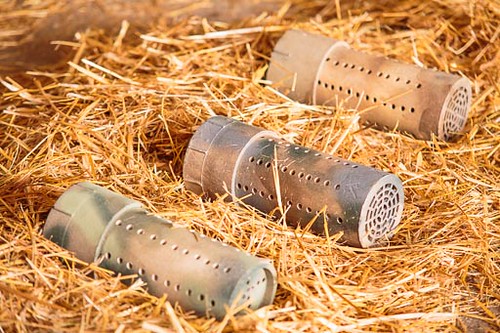Barn Hunt is a young sport, only a few years old. Participation has been growing fast, though, and barn hunt trials are getting easier and easier to find in many places. Here in Oregon, we have trials every few months put on by a few different clubs.
The basic idea of Barn Hunt is simple- dogs use their noses to find rats. Yes, live rats are used, however, they are kept safe from the dogs with PVC pipes. The rats generally are found calmly sleeping in the tubes and enter the tubes voluntarily, so I genuinely believe that they know they are safe and don't mind participating in this sport at all. Barn Hunt has very specific rules about the care and consideration of the rats, which can be read on their website.
You can start in either Instinct or Novice. In Instinct, three tubes are placed on the ground near each other. One tube is completely empty, one has soiled rat bedding, and one tube has a live rat it in. The goal in Instinct is for your dog to find the tube with the rat and indicate it in such a way that you, as the handler, are able to tell the judge which tube holds the live rat. As is suggested by the name, many dogs are naturals and can find the rat with no previous experience, using nothing but natural instinct. Some dogs, though, will benefit from prior exposure to barn hunt through a practice or seminar. Upon passing Instinct, your dog will receive a RATI title.
 |
| This is an actual set up during an Instinct test. The tubes are all in the open and placed near each other. |
The RATI (instinct) title is not required to enter your dog in Novice, the beginning level of Barn Hunt. In Novice, the same three tubes as pictured above are used. This time, though, the tubes are hidden in straw or hay bales. The goal is the same. The dog must find the tub that contains the live rat and indicate it in such a way that the handler is able to tell the judge where the rat is located. In addition to finding the rat tube hidden in the course, the dog is required to go through a tunnel made of straw bales and climb on top of at least one straw bale. No breed or size of dog is unable to participate as long as they can do these things- and I have seen Great Danes fit through the tunnels and dachshunds jump up onto a bale of straw.
 |
| This is a doberman in Instinct, sniffing each of the tubes to determine which one has the rat. He passed and gained his RATI title. |
After three Novice qualifications, the dog receives a RATN title and advances to Open. In Open, the goal remains the same. However, there are now two tubes with live rats and the dog must find both of them. The tunnel in Open is also longer. Senior comes after the RATO title, where there are four rats to find in a larger course.
 |
| This collie is searching for the hidden rat tubes in the bales of straw. |
Master is the highest level of Barn Hunt as is the most difficult. In Master, there are always 10 tubes in the ring, but the number of rats can be 1-5, with the rest of the tubes filled with bedding. The handler must indicate to the judge when their dog finds a rat, but also must tell the judge when the dog has cleared the ring and there are no more rats to be found. This requires not only that your dog has a strong indication when finding the rats, but also requires that the handler have total trust in their dog when they indicate no more rats are there to be found.
For more information about Barn Hunt, or to locate a trial or training group in your area, check out the official Barn Hunt website.
This sounds like something my Bailey would enjoy and probably be good at. I hadn't heard of it before and will check with our training. club to see if there are any events nearby.
ReplyDeleteThis sounds so fun and interesting! We love that the rats are not harmed and are well cared for. Hopefully we'll be trying a Barn Hunt event in the next few months :)
ReplyDelete